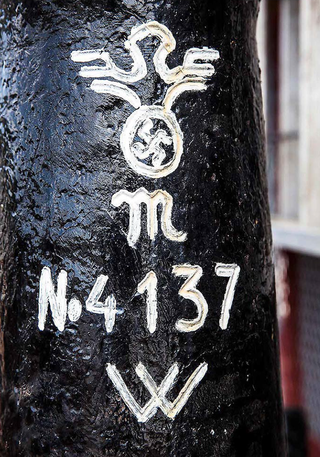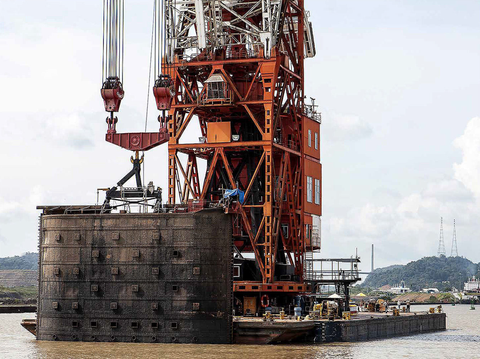The Floating Crane That Went From Tending Nazi U-Boats To Fixing the Panama Canal
Born to tend to Nazi U-boats, floating crane Titan (aka Herman the German) found new life in the U.S. Navy and helped revitalize the most ambitious canal project in human history.
By Tom Fowlks
TOM FOWLKS
The following is an excerpt from Tom Fowlks' This Is Panama.
Titan, better known by its former nickname Herman the German, is a large floating crane currently serving in the Panama Canal Zone, performing heavy lifts for Lock Maintenance.
The Crane, built in 1941 by Demag Cranes AG as Schwimmkran No. 1 for the Kreigsmarine, where it served in the Baltic Sea tending to German U-Boats. Of the four Schwimmkräne built by Demag, one was destroyed during World War II by bombs during the Operation Gomorrah bombing raid. the remaining 3 were seized by the Allies from the German Kriegsmarine as war reparations.
The British Schwimmkräne worked in Denmark after the war, but was sold to France and subsequently sank on transit in the North Sea when it capsized. The Soviet Schwimmkräne was sent partially assembled to Leningrad and was used temporarily as an artillery spotting tower. It was presumed lost after the war until it was spotted in 2015 working in the Admiralty Ship Yard in Saint Petersburg.
The fourth one went to the Americans.

Herman the German
TOM FOWLKS
Herman, or the Titan, is a large, self-propelled crane vessel with the tip of its main boom standing at 374 feet (114m) above the typical water line. In 1957, it was claimed to be the largest floating crane in operation. It’s rated capacity is 350 tonnes (340 long tons / 390 short tons) at up to 114 feet (35m) from the center of rotation. The lift capacity drops to 50 tonnes (49 long / 55 short tons) at 210 feet (64m) from center, and a single rotation about its pedestal takes roughly 10 minutes.
Herman was dismantled and transported across the Atlantic through the Panama Canal to Long Beach, where it subsequently served at the Long Beach Naval Ship Yard from 1946 to 1994 when the shipyard closed.

The Titan Crane at the Long Beach Naval Shipyard in 1982.
U.S. NAVY
Over the years, Herman performed numerous notable heavy lifts: Gun Barrels for the battleships USS Missouri and USS New Jersey in the 1980’s, steam locomotives for South Korea, the underwater habitat SEALAB II, the first atomic reactor on the West Coast and even lifting the Hughes H-4 “Spruce Goose” from its original hangar in Long Beach when it was relocated to its geodesic dome from 1980 to 1982 for a tourist display.
Following the closure of the shipyard, Herman was sold to the Panama Canal Commission and it was transported on the semi submersible ship Sea Swan in 1996 to the Panama Canal Zone, where it currently serves as the floating crane Titan. Upon Titan’s arrival, the Canal retired Ajax and Hercules, large cranes that served the Panama Canal since its construction in 1914.

A swastika remains soldered into the Titan’s original anchor.
TOM FOWLKS
But, by far the most interesting stories of Herman, or Titan, come from its crew in Panama. Many of these hardened men are afraid to spend time alone on the crane, insisting that it is haunted by Nazi ghosts. Tales of apparitions and voices coming seemingly from nowhere are rampant amongst these macho, Latino men.
The crane is over 75 years old and many of the fittings are still original. For example, on a visit to the Titan crane, one will see the original anchor, weighing 2500kg, with a Nazi Swastika soldered into the iron handle, and a visit to the control room reveals that A/C was only just added within the last few years.
But the most unsettling moment for me—beyond the Nazi ghosts—was the invitation to climb to the top of the 374-foot crane. Climbing a 75-year-old ladder that's longer than a football field.
"No thanks, amigo," I said. "I’ve got the photos I want and I have an appointment at the cervecería."

TOM FOWLKS
No comments:
Post a Comment